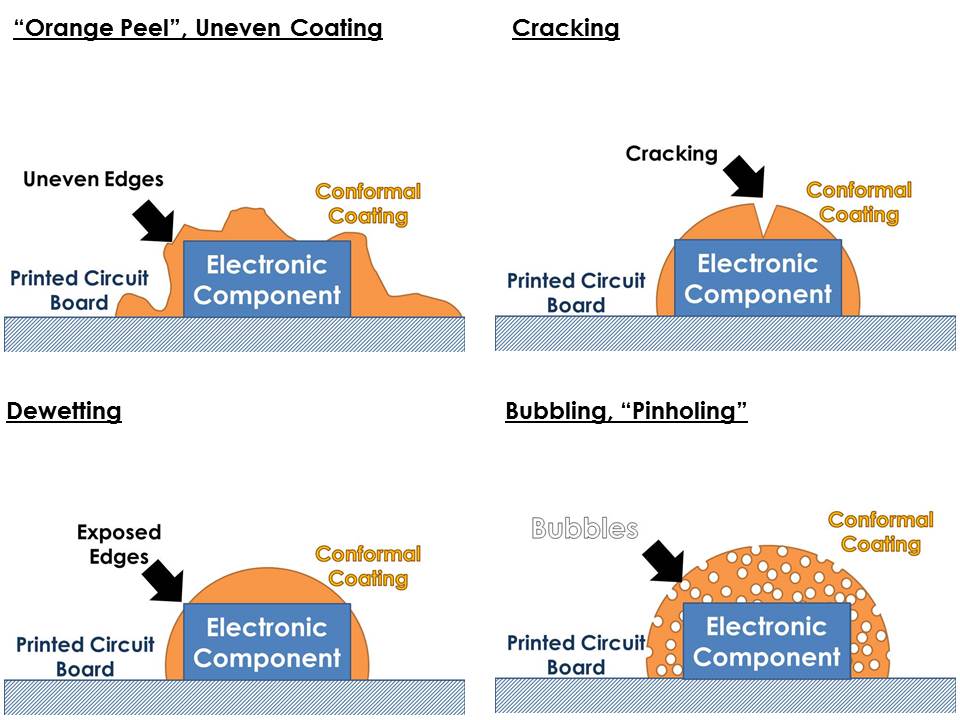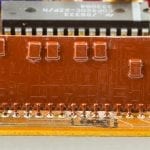The rheology and surface properties of conformal coatings have a direct effect on their application performance and are often analysed to predict and ensure suitability for a specific application method. This could be either by brushing, dipping, spraying, film coating or needle dispensing. The Centre for Industrial Rheology offers a range of materials characterisation methods to predict physical handling behaviour and to understand the performance of conformal coatings. We can provide measurement of viscosity across a range of shear conditions, coating structural characteristics such as rigidity and strength, dynamic analyses of wetting properties and surface tension measurements.
Whether you are trying to benchmark and compare conformal coatings from a range of suppliers, improve upon a formulation, or simply looking to develop a specification, we can help you quantify performance related metrics of your conformal coating and deliver this information in a clear, concise and easy to understand manner.
If you have a range of samples you would like us to characterise, please feel welcome to get in touch and ask how we can help.
What are the key physical metrics related to conformal coating performance?
Our customers often ask us “what should I measure?” This very much depends on the behaviour of interest. Do you want to minimise the use of fillers or dams by controlling physical properties of your conformal coating? What are the process and formulation parameters you can change and do you know to what extent they affect handling behaviours or properties? 
Our customers will often be able to observe and describe an issue, but have difficulty in identifying a suitable metric, or set of metrics that will help predict or explain the behaviour. Standard viscometers used are often limited in providing a clear understanding on conformal coating behaviour during application. In these cases we can work with you to identify a suitable toolkit of methods to enable you to compare poor and well performing conformal coatings. We’ll also take the time to help explain how these differences, or a combination of properties work together to affect an outcome.
Viscosity for Handling Behaviour and Application Process
 The viscosity of a conformal coating affects the handling behaviour and choice of application method. A high viscosity Newtownian conformal coating may be difficult to pump and spray, thus application techniques may be limited. Dip coating, brush coating or directed injection, each have their own unique limiting factors from level of effort, duration, precision, wastage, etc.
The viscosity of a conformal coating affects the handling behaviour and choice of application method. A high viscosity Newtownian conformal coating may be difficult to pump and spray, thus application techniques may be limited. Dip coating, brush coating or directed injection, each have their own unique limiting factors from level of effort, duration, precision, wastage, etc.
For non-Newtonian coatings (which change their viscosity depending on the shear rate applied), it’s vital to characterise viscosity across a range of shear conditions that mimic application or the process of interest. Creeping flow, self-levelling and movement of bubbles to the surface of a coating, occur under very low shear conditions, often beyond the reach of a simple viscometer.
Dynamic Wetting / Contact Angle for Adhesion
 A static contact angle measurement will give an indication of wettability of a conformal coating after it has reached equilibrium. High contact angles indicate poor wetting, suggesting that the coating may not adhere easily onto a PCB. A high contact angle for a conformal coating can be a predictor of delamination or preference to form an uneven surface. Low contact angles suggest good adhesion onto a substrate and can also indicate whether a coating will preferentially wet certain areas by capillary action or wicking.
A static contact angle measurement will give an indication of wettability of a conformal coating after it has reached equilibrium. High contact angles indicate poor wetting, suggesting that the coating may not adhere easily onto a PCB. A high contact angle for a conformal coating can be a predictor of delamination or preference to form an uneven surface. Low contact angles suggest good adhesion onto a substrate and can also indicate whether a coating will preferentially wet certain areas by capillary action or wicking.
Dynamic contact angle measurements can show how wetting properties and surface tension of a coating changes over time. This can be crucial in high speed processes where the time between deposition and curing of a conformal coating could be less than a couple of seconds. This is particularly true, if the coating preferentially de-wets or wets over this time period.
Yield Stress for Coating Thickness
 The coat thickness of a conformal coating is heavily influenced by its yield stress. Yield stress can be thought of as how hard you need to push a material until at achieves significant flow. If the weight of a coating lies above this value, it will continue to flow and spread under its own weight until it reaches the yield stress.
The coat thickness of a conformal coating is heavily influenced by its yield stress. Yield stress can be thought of as how hard you need to push a material until at achieves significant flow. If the weight of a coating lies above this value, it will continue to flow and spread under its own weight until it reaches the yield stress.
Coatings with a high yield stress are more likely to ‘structure up’ and possess solid like characteristics, forming well defined edges and shapes. This is useful property for damming compounds, gels and epoxies which act as barriers to protect specific areas of circuitry from coatings.
Thixotropic Profile for Post Deposition Recovery
 Thixotropy refers to the rate at which a material recovers to its original viscosity after shear. A coating with a slow thixotropic recovery may continue to flow after deposition, making it difficult to precisely control its application into a target area.
Thixotropy refers to the rate at which a material recovers to its original viscosity after shear. A coating with a slow thixotropic recovery may continue to flow after deposition, making it difficult to precisely control its application into a target area.
This may be a desirable property to control to enable self-levelling. Promoting flow of the material for a short period of time after deposition gives the coating a better chance to self-level before gradually resisting further movement.
Depending on your requirements, we can adapt and change our test methods to more closely replicate conditions experienced by conformal coatings. We utilise a number of statistical methods to help identify significant observations, and patterns of interest.
With every one of our reports we take the time to help you fully exploit our expertise by presenting data in a clear and concise manner over a number of calls or web meetings.
If you have a range of samples you would like us to characterise, please feel welcome to get in touch and discuss how we can help.
